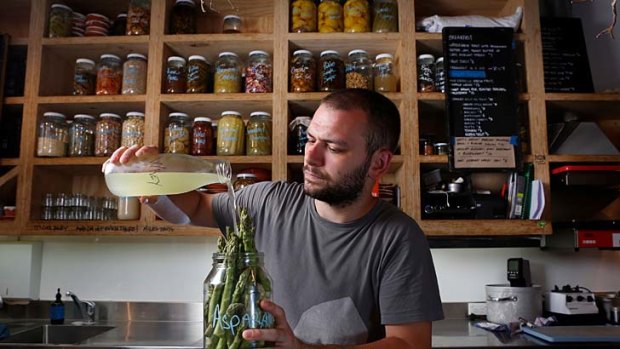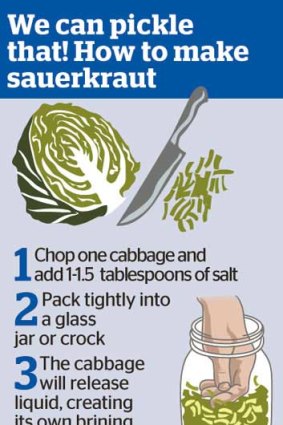Sometimes it pays to talk not of food trends but new food realities. Despite its cultish nature, its hipster-friendly label - enthusiasts are known as ''fermentos'' - and its consciousness-raising philosophy, the hype around fermenting is one such time.
Chefs are working up a lactic acid lather as they rediscover the art of fermenting food - otherwise known as letting beneficial bacteria do the work of preserving foodstuffs, altering taste and texture in the process.

Florent Gerardin, head chef at Silo by Joost in the CBD.Credit: Eddie Jim
From sauerkraut to kimchi, kefir to kombucha, ferments are quietly fizzing away in cafe and restaurant kitchens. ''Things have definitely gone sour,'' says The Age Under $30 editor, Simone Egger. ''Ferments feature on a lot of cafe and restaurant menus in this year's guide. I can't remember a time when two-week-old cabbage was more desirable than it is today.''
So why the spike in interest when fermentation has been used for thousands of years? The answer takes in the broad sweep of contemporary food culture. It's one of the ''lost'' culinary arts neglected since the introduction of industrialised food practices, now experiencing a revival.

It's also a sign of how our food trends are driven from far away, with influential Scandinavian chefs such as Magnus Nilsson from Faviken splicing basic survivalism with high art.
The movement's unofficial figurehead, Sandor Katz, author of Wild Fermentation and The Art of Fermentation, links it to consciousness-raising. Basically, if you've had a gutful of sterile, mass-produced and chemically treated food, fermentation is your antidote. Quite literally: fermented foods are full of good, gut-beneficial bacteria. It's a probiotic in food form.
Florent Gerardin, head chef at Silo by Joost in the CBD, where the US-based Katz is holding demonstrations this weekend, loves fermentation for its ability to stretch the seasons. ''It gives us the opportunity to serve asparagus or any vegetable out of season.'' Silo makes kombucha - fermented black tea - and mead, ''and when we have fruit going soft we make a nice fruit wine''. Their signature is fermented brown rice risotto - ''like I used to make at Vue de Monde, only fermented,'' says Gerardin.
Fermenting can also be delicious. It's associated with umami, the ''fifth taste'' after sweet, salt, sour and bitter. Fermentation is at the heart of ''the machinery of flavour'', says the food world's most influential trend leader David Chang.
Noma's Rene Redzepi has enthused about fermentation thus: ''[It's] where you'll find a lot of flavours that give that richness, the effect of 'Ahh, I feel like I've eaten something.'''
Alric Hansen from North Carlton's Small Victories says it's part of a chef's toolbox. ''It's the mentality of understanding products, building a repertoire,'' says Hansen, who makes his own kimchi. ''It's magical.''
Looking into the (fermented) tea leaves, its popularity will grow thanks to chefs now comfortably bored with pickling, fermentation's little sibling.
Kathy Reed from the CBD's Mesa Verde speaks for the chef fraternity when she says her adventures in pickling are leading in a hardcore direction. ''I've got Sandor Katz's book. Fermenting will be the next thing we try. Kimchi in winter, bring it on!''
The Age Good Food Under $30 will be available for $5 with The Age next weekend from participating newsagents, while stocks last. It is also available in selected bookshops and online at theageshop.com.au for $9.99.